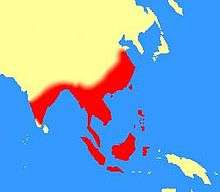Fasciolopsiasis
Fasciolopsiasis results from an infection by the trematode Fasciolopsis buski,[1] the largest intestinal fluke of humans (up to 7.5 cm in length), much shorter than many tapeworm but flukes being generally wider and unsegmented, the condition results in relative weight loss as a minimum.[2]
| Fasciolopsiasis | |
|---|---|
 | |
| Eggs of Fasciolopsis buski | |
| Specialty | Infectious disease |
Signs and symptoms
Most infections are light, almost asymptomatic. In heavy infections, symptoms can include abdominal pain, chronic diarrhea, anemia, ascites, toxemia, allergic responses, sensitization caused by the absorption of the worms' allergenic metabolites (may eventually cause death of patient), and intestinal obstruction.[3]
Cause
The parasite infects an amphibic snail (Segmentina nitidella, Segmentina hemisphaerula, Hippeutis schmackerie, Gyraulus, Lymnaea, Pila, Planorbis (Indoplanorbis)) after being released by infected mammalian feces; metacercaria released from this intermediate host encyst on aquatic plants like water spinach, which are eaten raw by pigs and humans. Water itself can also be infective when drunk unheated ("Encysted cercariae exist not only on aquatic plants, but also on the surface of the water.")[4]
Diagnosis
Microscopic identification of eggs, or more rarely of the adult flukes, in the stool or vomitus is the basis of specific diagnosis. The eggs are indistinguishable from those of the very closely related Fasciola hepatica liver fluke, but that is largely inconsequential since treatment is essentially identical for both.
Prevention
Infection can be prevented by immersing vegetables in boiling water for a few seconds to kill the infective metacercariae, avoiding the use of untreated feces ("nightsoil") as a fertilizer, and maintenance of proper sanitation and good hygiene. Additionally, snail control should be attempted.
Treatment
Praziquantel is the drug of choice for treatment. Treatment is effective in early or light infections. Heavy infections are more difficult to treat. Studies of the effectiveness of various drugs for treatment of children with F. buski have shown tetrachloroethylene as capable of reducing faecal egg counts by up to 99%. Other anthelmintics that can be used include thiabendazole, mebendazole, levamisole and pyrantel pamoate.[5] Oxyclozanide, hexachlorophene and nitroxynil are also highly effective.[6]
Epidemiology

F. buski is endemic in Asia including China, Taiwan, Southeast Asia, Indonesia, Malaysia, and India. It has an up to 60% prevalence in worst-affected communities in southern and eastern India and mainland China and has an estimated 10 million human infections. Infections occur most often in school-aged children or in impoverished areas with a lack of proper sanitation systems.[7]
F. buski was endemic in central Thailand, affecting about 2,936 people due to infected aquatic plants called water caltrops and the snail hosts which were associated with them. The infection, or the eggs which hatch in the aquatic environment, were correlated with the water pollution in different districts of Thailand such as Ayuthaya Province. The high incidence of infection was prevalent in females and children ages 10–14 years of age.[8]
References
- Lankester, E.; Küchenmeister, F. (1857). "Appendix B: On the occurrence of species of Distoma in the human body". On animal and vegetable parasites of the human body: a manual of their natural history, diagnosis, and treatment. 1. Sydenham society. pp. 433–7.
Odhner TH (1902). "Fasciolopsis Buski (Lank.)[= Distomum crassum Cobb.], ein bisher wenig bekannter Parasit des Menschen in Ostasien". Centr. Bakt. U. Par. XXXI. - ""Fasciolopsiasis" at Stanford.edu". Retrieved 2007-07-03.
- Bhattacharjee HK, Yadav D, Bagga D (2001). "Fasciolopsiasis presenting as intestinal perforation: a case report". Trop Gastroenterol. 30 (1): 40–1. PMID 19624087.
- Weng YL, Zhuang ZL, Jiang HP, Lin GR, Lin JJ (1989). "Studies on ecology of Fasciolopsis buski and control strategy of fasciolopsiasis". Zhongguo Ji Sheng Chong Xue Yu Ji Sheng Chong Bing Za Zhi (in Chinese). 7 (2): 108–11. PMID 2805255.
- Rabbani GH, Gilman RH, Kabir I, Mondel G (1985). "The treatment of Fasciolopsis buski infection in children: a comparison of thiabendazole, mebendazole, levamisole, pyrantel pamoate, hexylresorcinol and tetrachloroethylene". Trans R Soc Trop Med Hyg. 79 (4): 513–5. doi:10.1016/0035-9203(85)90081-1. PMID 4082261.
- Probert AJ, Sharma RK, Singh K, Saxena R (1981). "The effect of five fasciolicides on malate dehydrogenase activity and mortality of Fasciola gigantica, Fasciolopsis buski and Paramphistomum explanatum". J Helminthol. 55 (2): 115–22. doi:10.1017/S0022149X0002558X. PMID 7264272.
- Keiser J, Utzinger J (2009). "Food-borne trematodiases". Clin Microbiol Rev. 22 (3): 466–83. doi:10.1128/CMR.00012-09. PMC 2708390. PMID 19597009.
- Sadun EH, Maiphoom C (1953). "Studies on the epidemiology of the human intestinal fluke, Fasciolopsis Buski in Central Thailand". American Journal of Tropical Medicine and Hygiene. 2 (6): 1070–84. doi:10.4269/ajtmh.1953.2.1070. PMID 13104816.
Further reading
- Graczyk TK, Gilman RH, Fried B (2001). "Fasciolopsiasis: is it a controllable food-borne disease?". Parasitol. Res. 87 (1): 80–3. doi:10.1007/s004360000299. PMID 11199855.
- Mas-Coma S, Bargues MD, Valero MA (2005). "Fascioliasis and other plant-borne trematode zoonoses". Int. J. Parasitol. 35 (11–12): 1255–78. doi:10.1016/j.ijpara.2005.07.010. PMID 16150452.
- http://www.ijmm.org/text.asp?2017/35/4/551/224440
- Fasciolopsiasis in children: Clinical, Sociodemographic Profile and outcome. Indian Journal of Medical Microbiology2017 vol 35, issue 4 page 551-554
DOI:10.4103/ijmm.IJMM_17_7